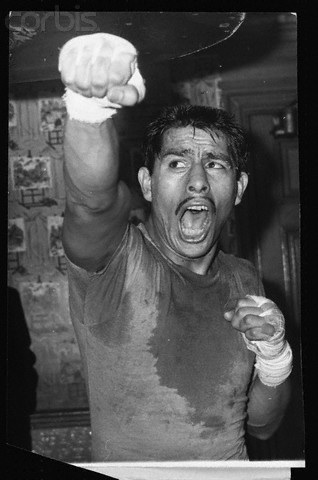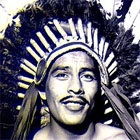Tijuana is a fight town. It has always been and it always will be. As the city produces its own champions, it also welcomes a multitude of fighters from farther south in Mexico who come to the border town for the same reason as many of their compatriots do, to look for a better life for themselves and their families on the north side of the border.

As the strong winds that once belonged to the “Tijuana Tornado’ have slowed down to a breeze since his suspension from professional boxing, Tijuana must now look towards the future for a new star. The only one on the horizon is the #1 ranked WBC lightweight Antonio DeMarco as he prepares to battle for the interim lightweight title at the end of the month. Since the pickings are slim, there is no better time to look at the past for a boxing superman. With the likes of former champions Erik Morales, Alejandro “Terra” Garcia and Raul “Jibaro” Perez enshrined in the pantheon of Tijuana boxing and even current super featherweight champ Humbero “Zorrita” Soto, Jorge “travieso” Arce and the great Julio Cesar Chavez having made Tijuana their boxing home, we must go farther back to learn about one of the first Tijuana fighters to make a name for himself on either side of the border.
His name is Gaspar “Indio” Ortega.
“I met him in 1957 and I had the pleasure sparring with him two rounds,” Benjamin Rendon, the current boxing commissioner of Tijuana says smiling. “Obviously he took it easy with me since I was a lightweight and he was a welterweight plus by that time he had already fought in New York City.”
Despite what Boxrec.com reports, Ortega began his career in 1950 and it spanned for 185 bouts within 15 years all in the welterweight division (Boxrec.com reports a record of 131-39-6, 69KO).
“Indio” Ortega was part of the main event in twenty-five fights at the mecca of boxing, Madison Square Garden in New York City and in forty-four fights which were broadcast “coast to coast” when national coverage meant something.
Think Elvis Presley, The Beatles or the JFK assasination.
“When he fought, the traffic in Tijuana stopped,” Rendon remembers. “It was like in the movies where people would crowd around the street side windows of furniture stores watching his fights. Tijuana has about two million residents now and it is difficult for the Municipal Auditorium that seats about five thousand to sell out. When Gaspar fought in the fifties, he would sell out the bullring, twenty-five thousand, and Tijuana back then had about three hundred thousand residents.”
Originally from Mexicali, MX, Ortega landed as a toddler in Tijuana and considers himself a Tijuana native.
“I got to the gym because of my older brothers, they all fought,” the very lucid Ortega reminisces. “In the beginning, I saw it as a job. I liked that I could make 2,3 or even 10 pesos that I could take home. I was fourteen years old and by the time I was fifteen, I was fighting in the amateurs.”
By 1950, he was crowned the Baja California amateur champion and in the same year, he made his debut as a professional.
“I remember it was in the month of May, but I don’t recall the day,” the almost seventy-four year old Ortega suprinsingly recollects. “Before the fight, I had to go pee every three minutes because I was so nervous but once I climbed into the ring and began to box, everything changed. I used everything I had learned in the gym.”
Despite winning his first fight, a four rounder at the famed and now non-existant Arena Mexico in Tijuana, Ortega had other, much more dangerous career plans.
“I wanted to be a bullfighter,” he states seriously. “I had done many novilleras, basically practice bull fights with much smaller bulls. One day a small bull got me, close to my groin and that is when I decided to stop. It was too dangerous.”
By his first professional fight, Ortega had earned his nickname of “Indio” or the “Indian”. His parents who were from Oaxaca had all the features of the indegenous people of that region with his mother fitting the bill to a T, according to Ortega. Ortega soldiered on, fighting practically once a month if not more often as it was the style of the day.
“We didn’t earn as much back then so we fought more often,” Ortega states. “Most of the time they  would tell us days in advance, sometimes with no warning at all. Even if I wasn’t training, they would go look for me at my house and tell me I was fighting the following Monday. If I was lucky, they would give me my opponent’s name. Once I fought on Monday, I would be back in the gym on Tuesday.”
would tell us days in advance, sometimes with no warning at all. Even if I wasn’t training, they would go look for me at my house and tell me I was fighting the following Monday. If I was lucky, they would give me my opponent’s name. Once I fought on Monday, I would be back in the gym on Tuesday.”
After roughly twenty-one consecutive wins, Ortega suffered his first loss after taking the longest hiatus of his career, five months.
“My conditioning at that time did have a little to do with my first loss but mostly it was because I wasn’t sure if I wanted to continue to fight,” Ortega says. Since fighting was a big part if not the only part of Gaspar’s income at the time, the fact that the local promoters would sometimes not have him fight for weeks at a time made Ortega think twice about his chosen profession.
“That time they left me without fighting for like two or three months. I had to resort to selling newspapers to put food on the table,” Ortega explains. “I had to run all around town picking up the newspapers and in a way that helped me with my conditioning but not enough to win that fight.”

